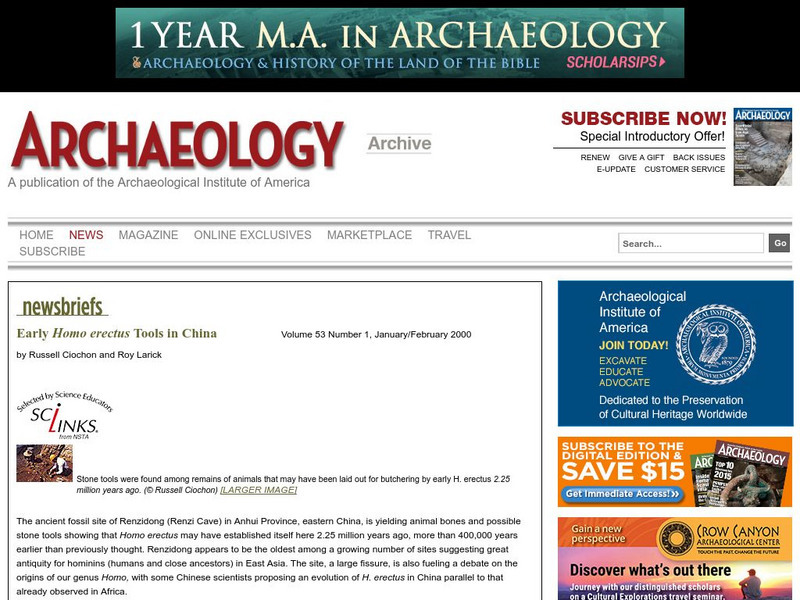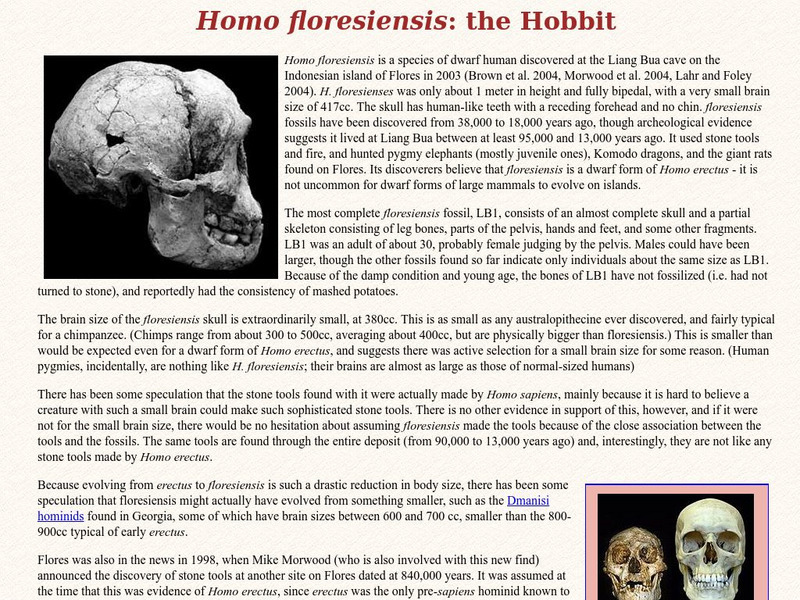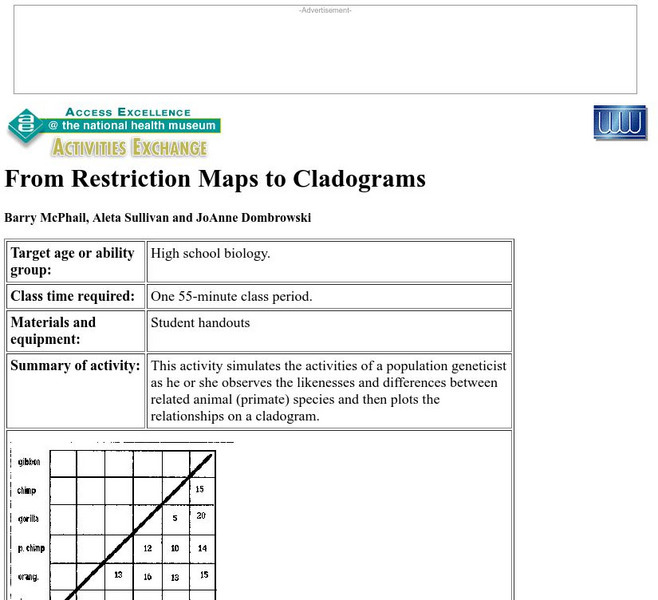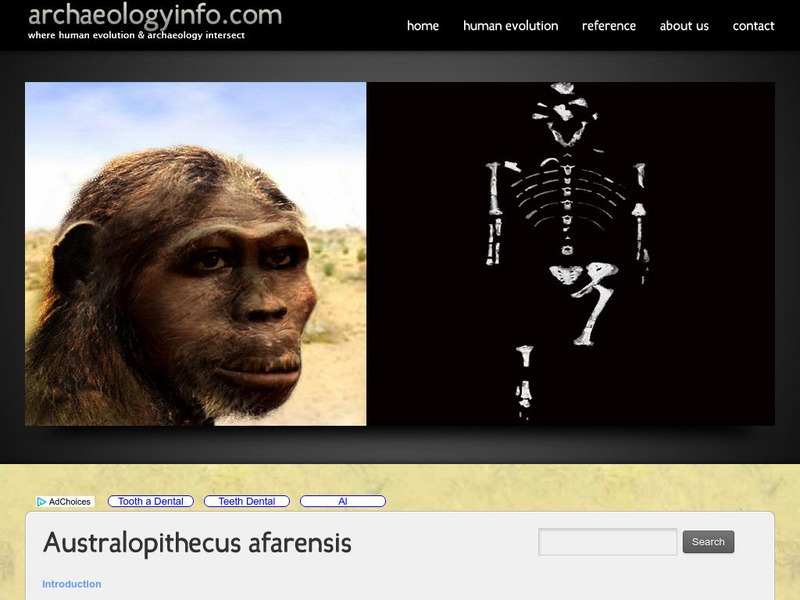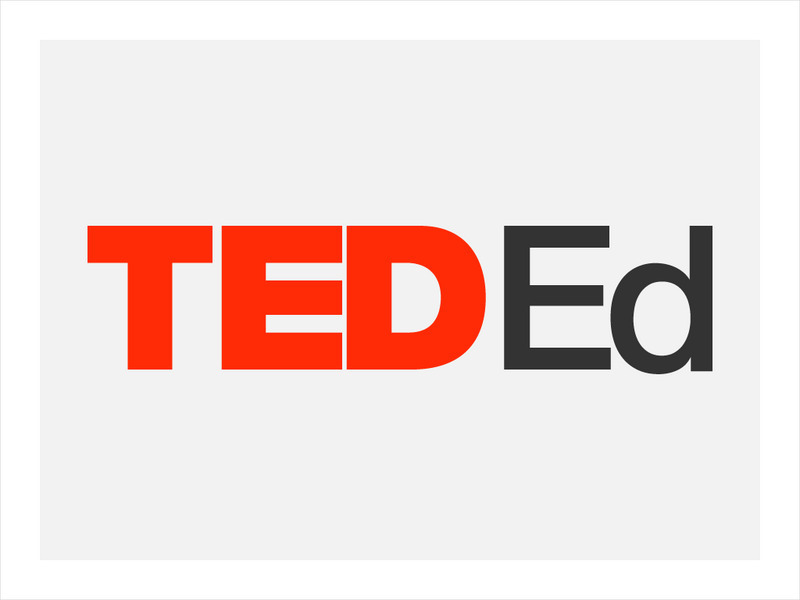Hi, what do you want to do?
Curated OER
Smithsonian Nmnh: What Does It Mean to Be Human, Human Evolution Evidence
What does it mean to become human? This brilliant and detailed resource examines early man's behavior, including information on stone tools he used, burial, clothing, and shelter. Find information on genetics including human skin color...
Archaeological Institute of America
Early Homo Erectus Tools in China
An article which describes a fossil site in eastern China where evidence has been found that Home erectus may have been active in eastern China some 400,000 years earlier than scientists believed. The authors also summarize the debate...
BiologyWise
Biology Wise: A Comparative Analysis: Homo Habilis vs. Homo Erectus
Describes Homo habilis and Homo erectus, two early ancestors of humans. Discusses how they were discovered, their characteristics, and what we know about them, with the information clearly laid out in a chart along with some comparative...
Smithsonian Institution
National Museum of Natural History: Homo Habilis
This resource provides graphics, as well as explanation, of the remains of Homo habilis.
PBS
Pbs Teachers: Scientific American: Science Safari: The First People
Emulate the work of archaeologists in South Africa attempting to solve the riddles of human evolution by inferring a person's height from the length of one bone. Identify and communicate present-day rituals through ancient art techniques.
TED Talks
Ted: Ted Ed: How Did Teeth Evolve?
Peter S. Ungar traces the evolution of mammalian molars from primitive cone-like structures to the myriad forms of today's species, from lions to cows to people.
Khan Academy
Khan Academy: Activity: Claim Testing: Collective Learning
An exercise where students will make determinations about whether claims about collective learning are true or false using the claim-testing procedure.
Palomar Community College District
Palomar College: Neandertals
Who were the Neandertals? Where did they live? Find thorough research about these early humans offered by Dr. Dennis O'Neil.
Khan Academy
Khan Academy: The Four World Zones
Learn about four groups of humans developed from non-connected geographic zones due rising seas. Human history can be explained by this division.
Khan Academy
Khan Academy: Gallery: Agriculture
Over the course of many years, humans evolved to abandon foraging and took up farming for their food needs. Scientists are still not sure why humans abandoned foraging and took up farming in several places around the world at about the...
Talk Origins Archive
Talk Origins: Homo Floresiensis: The Hobbit
Article discusses the find in 2003 of fossils that are thought to be a dwarf human species. Please note that there are creationist responses listed as well as rebuttals.
BBC
Bbc: 'Lucy's Baby' Found in Ethiopia
In September 2006, the bones of a female Australopithecus Afarensis were unearthed. This extremely rare juvenile specimen allowed scientists a new insight into characteristics of an important human ancestor.
Palomar Community College District
Palomar College: Flashcards: Homo Heidelbergensis & Neandertals
Thirteen flashcards featuring facts about early modern humans.
Bagheera
Bagheera.com: Extinct in the Wild Neanderthals
This is quite a thought provoking article putting neanderthals in the category of extinct animals. Most of us have not thought of early human ancestors in this way, but this article and the thought questions at the end provide some good...
Khan Academy
Khan Academy: Threshold Card: Threshold 7: Rise of Agriculture
An infographic about how human civilization changed as they moved away from forging for food to farming.
National Health Museum
Nhm: Restriction Maps to Cladograms Lesson
This lesson plan requires students to analyze DNA restriction maps to determine the differences in the sequence for several primates and humans. They then use the information to create a cladogram.
CK-12 Foundation
Ck 12: Earth Science: Life and the Geologic Time Scale
[Free Registration/Login may be required to access all resource tools.] Describes relationship between evolution and the geologic time scale.
Other
Archaeology Info: Australopithecus Afarensis
This site provides information on the Australopithecus afarensis, a species that is believed to be a human ancestor.
PBS
Pbs Learning Media: The Transforming Leap, From Four Legs to Two
John Noble Wilford, a "New York Times" science writer, outlines various hypotheses on the origin of bipedalism.
PBS
Pbs Learning Media: Molecular Clocks: Proteins That Evolve at Different Rates
In this graphic and article from "The Human Evolution Coloring Book" by Adrienne Zihlman, four different proteins from humans and horses are compared and the reasons each protein evolves at its own characteristic rate are discussed.
TED Talks
Ted: Ted Ed: Vs Ramachandran: The Neurons That Shaped Civilization
Video explores the recent research and information on mirror neurons, which are thought to have influenced human evolution. [7:44] Includes a short quiz and a list of additional resources to explore.
TED Talks
Ted: Ted Ed: Why Are Some People Left Handed?
Today, about one-tenth of the world's population are southpaws. Why are such a small proportion of people left-handed -- and why does the trait exist in the first place? The following video investigates how the uneven ratio of lefties...
BBC
Bbc Schools: Ks2 Bitesize: Science: The Living World
This landing page includes learning modules on the following topics of: animals, plants, microorganisms, life cycles and reproductions, food chains, habits, humans and the environment, adaptation, inheritance, and evolution.
University of California
Ucmp: Introduction to the Carnivora
Nice informational site about the order Carnivora. The opening page lists members of the order and briefly describes relationships between humans and carnivores. It links to pages on evolution of carnivores, the ecological roles of...
Other popular searches
- Human Evolution Webquest
- Stages of Human Evolution
- Human Evolution Cladogram
- Human Evolution Chart
- Human Evolution Web Quest
- Human Evolution Skull
- Human Evolution Food Chain
- Evidences of Human Evolution
- Human Evolution Skull Lab
- Human Evolution Cardiogram
- Human Evolution Dogs
- Human Evolution Time Line






